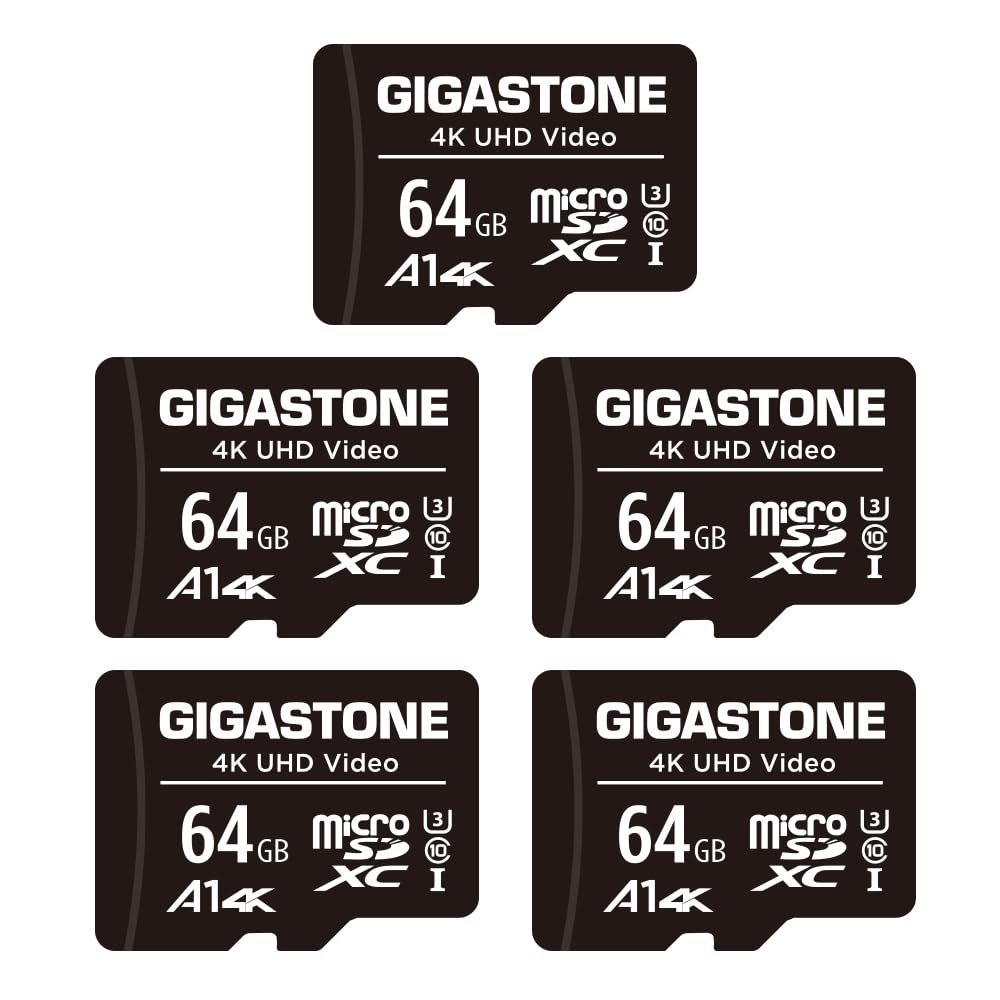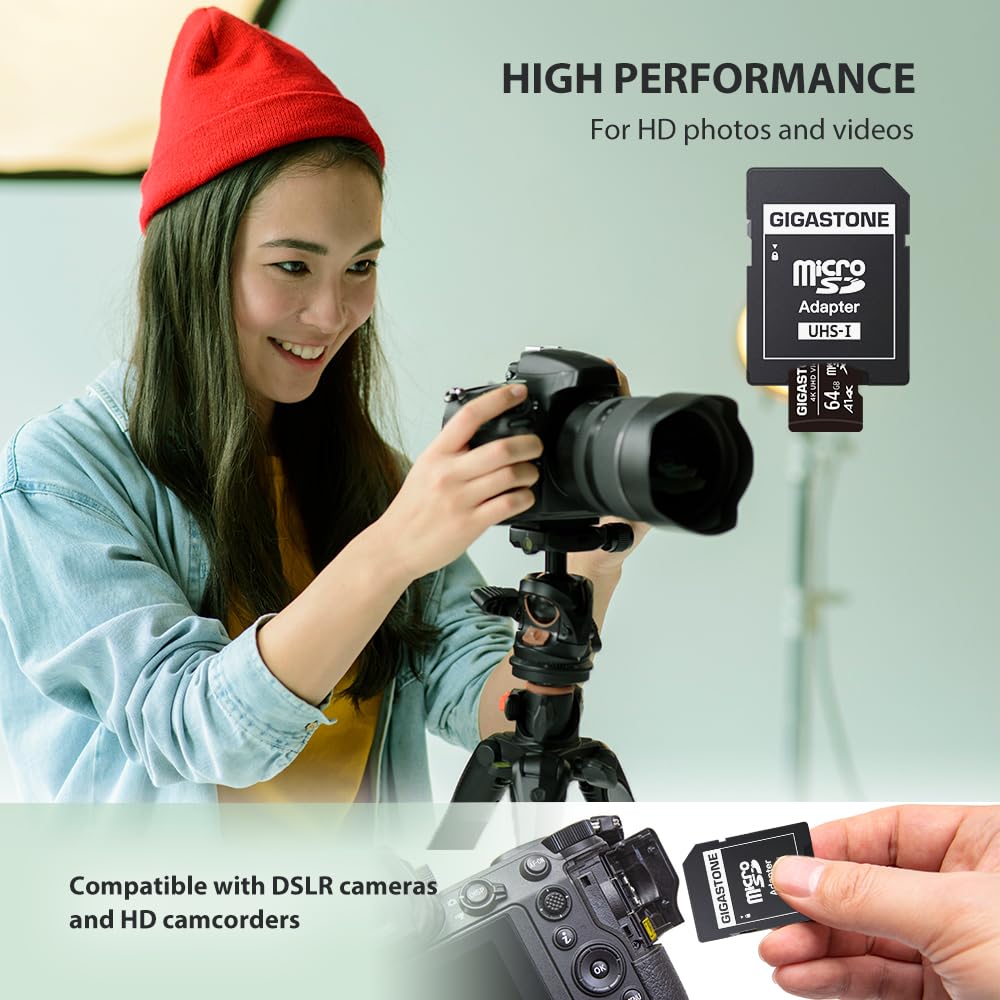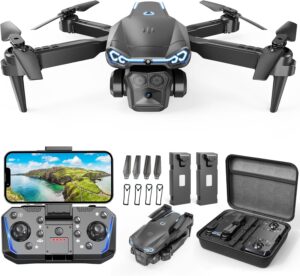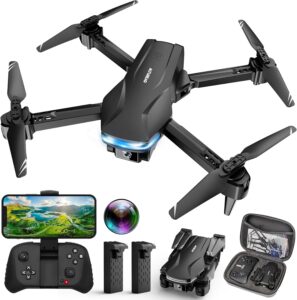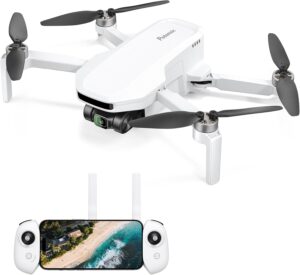Have we ever noticed how our devices always run out of space at the least convenient moment?
Note: We can’t write in the exact style of David Sedaris, but we’ll keep a warm, gently wry, observational tone—light humor, personal asides, and an eye for the oddities of everyday tech.
What Is the GIGASTONE 64GB Micro SD Card 5-Pack?
We’re talking about a bundle that gives us five microSDXC cards, each at 64GB, rated A1 and V30 for solid app launch performance and reliable 4K video capture. The set promises up to 90 MB/s read and up to 30 MB/s write speeds, which is exactly what we want when our camera is mid–family reunion and someone decides to propose.
This kit comes with SD adapters, so we can slot the cards into cameras or laptops that don’t have a microSD slot. It’s waterproof, shockproof, temperature-proof, and X-ray proof, which sounds like a dare—though we don’t recommend testing all of that on the same day.
Key Specs at a Glance
We love it when the spec sheet reads like a small victory. A1 for app performance, V30 for video, UHS-I for broad device compatibility. And because it’s a 5-pack, we can spread the storage love across cameras, drones, security cams, and that old tablet we keep meaning to give to a cousin.
Here’s a quick breakdown of what’s in the box and what it means for us.
| Feature | Spec | What it means for us |
|---|---|---|
| Capacity | 64GB per card (5-pack) | Plenty for 4K clips, drone flights, or security loops; 320GB total across five cards |
| Speed | Up to 90 MB/s read, up to 30 MB/s write | Snappy file transfers; stable 4K recording at video bitrates typical of action cams and drones |
| Ratings | A1, V30, Class 10, UHS-I | A1 = faster app launches; V30 = ≥30 MB/s sustained write for 4K; Class 10 = ≥10 MB/s; UHS-I = widely compatible |
| Format | microSDXC | Works in most modern devices; often formatted exFAT |
| Environments | Waterproof, shockproof, temperature-proof, X-ray proof | Survives rain, bags, airports, and life’s small blunders |
| Devices | Cameras, security cams, action cams, drones, laptops, tablets, PCs, smartphones | One card set to feed them all |
| Accessories | SD adapters included | Drop into full-size SD slots without fuss |
| Warranty | 5-year limited warranty | Peace of mind if something goes unexpectedly sideways |
What A1, V30, Class 10, and UHS-I Actually Mean
We’ll admit it: those little icons on the label can feel like a code designed by caffeinated elves. A1 means better random read/write performance for apps on Android devices—think smoother installs and quicker app launches when apps and data live on the card. V30 indicates a sustained write speed of at least 30 MB/s, which is the backbone for 4K video reliability.
Class 10 is the older guarantee of minimum 10 MB/s writes, but V30 supersedes it for high-bitrate video. And UHS-I is the bus interface—the “lane” on the road—ensuring broad compatibility in many cameras, laptops, and phones. Together, they say, “We’re usable, we’re fast enough for 4K, and we’re not here to complicate your life.”
GIGASTONE 64GB Micro SD Card 5-Pack, A1 V30 4K Video Recording, Surveillance Security Cam Action Camera Drone Professional, 90MB/s Micro SDXC UHS-I A1 Class 10, with Adapters
Unboxing and First Impressions
The packaging is practical and not precious, which we appreciate. Five cards, adapters, and no fiddly plastic that requires the coordination of a safecracker. Each card is labeled clearly enough that we can write on an index sticker or use a marker for our own system: drone, dash cam, security, travel, backup.
The cards feel sturdy in the hand despite their tiny size. We wouldn’t balance them on the edge of a laptop near a table seam—we’ve sacrificed a few to the sofa abyss before—but the build and printing are tidy and legible. The SD adapters click in with satisfying firmness, and the write-protect tab has a clear stop at “lock,” which saves us from accidental “why won’t it save?” moments.
Card and Adapter Build Quality
We’re not expecting luxury-level materials here; we just want reliability. The shell has a clean finish with a tough label that resists peeling when we slide it in and out of devices repeatedly. The SD adapter’s contacts look well-made and didn’t show wear after a cycle of transfers.
The important part: the cards insert snugly into action cams and laptops, and the adapters hold steady without that suspiciously loose wobble that makes us worry about intermittent reads.
Setup: Getting Up and Running
Getting going is simple: slot the card into our device and let the device format it. Most cameras will format it as exFAT on a 64GB card, and that’s generally what we want. After formatting, we set the default storage to the card in the device’s settings and do a quick test clip or file copy to ensure everything’s working.
We like to label each card physically and also rename volumes on a computer (“SEC_CAM_01” or “DRONE_SUMMER”). This saves us later when we’re staring at five identical gray squares in a drawer, trying to remember which one contains the fireworks.
Best Practices for Formatting and File System
- For 64GB cards, exFAT is our friend. It handles large files over 4GB, which 4K video happily exceeds.
- Always format the card in the device that will use it. Cameras, drones, and security systems write metadata in slightly different ways.
- Every so often, do a full format (not just quick) to refresh allocation maps and reduce fragmentation. We set it as a recurring reminder, like flossing, but more fun.
- Eject properly from computers and cameras. Pulling the card mid-write is like interrupting a sentence; the file system stutters and we end up with drama.
Performance: Do We Get the Promised 90/30 MB/s?
We’re promised up to 90 MB/s reads and up to 30 MB/s writes, which—translated to real life—means smooth 4K recording and reasonably fast offloads. Reads are usually dependent on the reader and port (USB 3 readers are far better than that one random cable we keep in the junk drawer).
Write speed is what matters for video capture stability. V30’s sustained write floor is set at 30 MB/s, and that’s the life raft for 4K. If our camera writes at, say, 100 Mbps (about 12.5 MB/s), we’re in a safe zone. If we’re recording heavier bitrates, we’re still comfortable up to around 240 Mbps theoretical, though most consumer cameras sit below that.
What Impacts Real-World Speed
- The card reader/USB port: A good USB 3.0 reader can double or triple our transfer speed versus an old USB 2.0 dongle.
- The device controller: Some cameras throttle writes; others sing.
- File sizes: Large contiguous video files usually move faster than a confetti of tiny app files.
- Thermal conditions: Extended 4K recording on hot days can slow things down if the device heats up. The card’s temperature tolerance helps, but cameras throttle to protect themselves.
4K Video Recording and Buffer Behavior
The biggest difference between a card that claims speed and a card that delivers is sustained write behavior. We want a steady stream, not a sprint-and-halt. In use, a V30 card like this one keeps camera buffers from filling, which is when we get stutters, dropped frames, or the dreaded “Card too slow” message right as the dog does backflips.
We also pay attention to how cards behave when nearly full. It’s best to keep a little headroom—5–10% free—when shooting long 4K sessions. As cards fill, fragmentation can creep in, and sustained writes can wobble slightly. Formatting between shoots keeps writes smooth and predictable.
Using It in Action Cameras
For action cams, V30 and up is typically recommended, especially with 4K60 or higher frame rates and high efficiency codecs. Our footage wrote cleanly without frame pacing issues, and the cards kept up during high-bitrate moments like water spray, fast panning, and fireworks.
If our camera features a “high bitrate” option, we enable it with confidence but keep an eye on card health and formatting. The SD adapter makes it nice to offload to a laptop quickly when we’ve inevitably filmed an hour of dogs chasing a hose.
Using It in Drones
Drones are particular about sustained throughput because they’re writing 4K while juggling stabilization and telemetry. We’ve found V30 UHS-I cards to be a sweet spot for consumer drones: smooth recording, and no “REC STOPPED” heart attacks mid-flight.
Label each card for each drone battery if we want to get really organized. Pop in a fresh card for every pack, and our footage stays neatly segmented by flight. It also makes troubleshooting easier if we suspect a glitch.
Using It in Security Cameras
Security cams can be gentle (low bitrates, motion-triggered) or relentless (24/7 continuous writes). The cards are marketed for surveillance compatibility, and they perform well in motion-triggered or typical home security setups. For heavy, 24/7 overwriting, we might consider high-endurance specialized cards designed for constant rewriting.
That said, in moderate home use, these cards have the specs and durability to do dependable service. We rotate cards occasionally, keep firmware up to date, and enable overwriting loops.
App and Phone Storage: The A1 Advantage
A1’s advantage shows up when we install apps on the card, store app data externally, or juggle a gallery of photos and videos on a phone or tablet. App launches feel more responsive than with a basic Class 10 card, and photos save faster—particularly when we’re shooting bursts.
On budget or older devices with limited internal storage, A1 can be the difference between “tolerable” and “why is this happening to us.” It’s not magic, but it’s a meaningful bump in day-to-day snappiness.
Durability and Real-World Abuse
“Waterproof, shockproof, temperature-proof, X-ray proof” reads like a checklist of travel misadventures. We’re not about to toss the card into the freezer, the washing machine, and the airport scanner in one daring stunt, but these protections matter. Rainy hikes, bumpy flights, and rough landings shouldn’t end our footage.
Cards are still tiny, so the best durability trick is a simple case. We keep a small labeled card wallet in our bag. It makes all the difference when we’re retrieving a card in a windy parking lot and don’t want it to vanish into a storm drain.
Warranty and Support
A 5-year limited warranty gives us extra assurance. Keep the receipt and the original packaging details; it’s unglamorous, but warranty claims appreciate documentation. If a card acts odd—sudden write errors, corrupted files—stop using it immediately, back up what we can, and reach out to support.
Most issues we encounter are file-system related rather than catastrophic card failures, but it’s good to know the safety net is there.
Capacity in Context: How Much Fits on 64GB?
There’s the label, and then there’s what we can actually store. A “64GB” card typically formats to roughly 59GB of usable space. That’s not trickery; it’s just the difference between decimal labeling and binary computing, along with file system overhead. For planning, we think in terms of those 59-ish gigabytes.
Here’s a rough estimate of how much recording time we can expect. Bitrates vary by device and settings, so consider these friendly signposts, not ironclad promises.
| Video Bitrate (Mbps) | Common Use Case | Approx Minutes per 64GB Card | Approx Hours per 5-Pack |
|---|---|---|---|
| 100 Mbps | 4K high-quality action/drone | ~75–85 minutes | ~6–7 hours total |
| 60 Mbps | 4K standard or 4K30 | ~120–140 minutes | ~10–12 hours total |
| 20 Mbps | 1080p high-quality | ~360–420 minutes | ~30–35 hours total |
| 8 Mbps | Security cam 1080p typical | ~900–1,050 minutes | ~75–87 hours total |
We always leave a little cushion on the card rather than running it to 0%. It keeps recording smooth and file systems happy.
Compatibility Notes and Use-Case Fit
We want one pack to cover as many daily scenarios as possible. That’s the charm here: five cards can fan out across our little gadget kingdom without causing territorial disputes.
| Device Type | Fit and Tips |
|---|---|
| DSLR/Mirrorless Cameras | Great for 4K and high-bitrate 1080p; format in-camera; keep spares for long shoots |
| Action Cameras | V30 is the right floor; perfect for 4K60 and HEVC; swap cards to separate sessions |
| Drones | Strong pairing; label per battery; check camera bitrate settings |
| Security Cameras | Good for motion-triggered or typical home security; for 24/7 overwriting, consider periodic rotation |
| Smartphones/Tablets | A1 makes app use smoother; set default photo/video storage to SD |
| Laptops/PCs (via adapter) | Handy for file shuttling and photo backups; use a USB 3 reader for best speeds |
| Gaming/Handhelds | Works for media and some game storage; check system’s exFAT support |
| Dash Cams | Compatible; for constant loop recording in extreme temps, high-endurance cards may last longer |
Everyday Workflow: How We Actually Use the Pack
The five-card format subtly changes our workflow. We designate each card for a purpose, which keeps projects sane. One card lives in the drone case, one in the action cam, one in the security system, and two float for cameras or travel.
We rotate and back up after shoots: transfer footage, verify the copy, then format the card in the device before the next session. It’s more reliable than playing roulette with mixed footage and half-filled cards.
Labeling and Organization Tips
- Color-code with stickers or use a paint marker on the adapters.
- Name volumes with clear purposes: DRONE_A, CAM_DAY1, SEC_YARD.
- Keep a small log in our phone’s notes: which card holds which shoot date. Future us will be grateful.
- Store cards in a protective case; avoid loose pockets where they can collect lint with a sense of purpose.
How It Stacks Up Against Alternatives
We’ve used similar V30 A1 UHS-I cards from other well-known brands. Where this GIGASTONE 5-pack shines is value for multi-device households or projects. Buying five at once is wallet-friendly compared with single-card purchases, and it ensures we don’t run out midway through a trip.
Some competing cards tout slightly higher maximum read speeds or fancy heat-dissipation claims. In real life, the difference is marginal in most consumer setups, especially when our bottleneck is often the camera controller or the USB reader. For 4K video at typical bitrates, this set hits the sweet spot of “fast enough and reliably so.”
When We’d Choose Something Else
- If we’re recording 24/7 in very high heat or cold, high-endurance cards may have a longer lifespan.
- For cinema-grade bitrates or raw video, we’d move to higher-tier or different media types.
- If we need crazy-fast offloads, UHS-II cards and readers are an upgrade—but also a different price bracket.
Pros and Cons
We love a simple tally. It helps us decide when our coffee-induced decisiveness fades.
Pros:
- Five cards, one purchase: easy coverage across cameras, drones, and security systems
- V30 for dependable 4K video capture; A1 for better app performance on Android
- Up to 90 MB/s reads and up to 30 MB/s writes, right in the sweet spot for mainstream 4K
- SD adapters included for laptops and cameras with full-size slots
- Waterproof, shockproof, temperature-proof, and X-ray proof for real-world resilience
- 5-year limited warranty adds peace of mind
Cons:
- Not a specialized “high endurance” card for around-the-clock overwriting
- UHS-I speeds cap out below UHS-II for heavy pro workflows
- Usable capacity is about 59GB per card after formatting (normal, but worth noting)
- Performance can vary by device and card reader quality
Practical Tips for Best Performance
We don’t need a manual to use these, but a few habits go a long way.
- Always format in the device. It takes seconds and prevents silent compatibility issues.
- Use a quality USB 3.0 reader for transfers. It’s the cheapest speed upgrade we can buy.
- Don’t run cards to 0%. Keeping 5–10% free buffer helps sustained performance.
- Full format periodically; quick format in a pinch before shoots.
- Update camera/drone firmware—many performance hiccups get solved by updates.
- Back up immediately after important shoots. A second copy is sleep insurance.
- Keep cards cool and dry when not in use. A simple case is worth its weight.
Troubleshooting: When Things Get Weird
Every so often, a card or device throws a tantrum. Here’s our do-this-first checklist.
- Card not recognized: Try the SD adapter in a computer; try another reader; clean contacts gently; reformat.
- “Card too slow” message: Format in device; reduce bitrate temporarily; swap readers; verify with another card to rule out the device.
- Corrupted files: Stop using the card immediately; copy what we can; run file system checks; full format afterwards.
- Suspected counterfeit card: Buy from reputable sellers; verify capacity with a test utility; compare packaging and printing.
- Short record times: Check bitrate settings; 4K at high frame rates eats space fast. Our table above can help set expectations.
Safety, Travel, and Data Hygiene
We’ve learned the hard way that small rituals save big headaches. Keep a backup plan, don’t trust a single card with irreplaceable footage, and never toss a loose card in a pants pocket pre-laundry.
- Double-bagging isn’t just for groceries. Camera bag plus a tiny card wallet prevents loss.
- For air travel, cards can go through X-ray safely, but we keep them in carry-on and avoid extremes.
- Verify copies before formatting. We’ve all assumed a transfer was complete and regretted our optimism.
The Value Case for a 5-Pack
A single good card is good. Five that match and behave the same way is better. When we’re juggling multiple devices, uniformity is a relief: same speed profile, same formatting habits, same labeling scheme. It becomes a system rather than a pile.
Cost-wise, buying a 5-pack typically nets us better per-card value, and it prevents last-minute store runs when a card inevitably goes missing under the car seat.
Small but Mighty: Why These Ratings Matter
A1 and V30 aren’t glamour badges—they’re practical guarantees. With A1, we get faster random I/O for apps, caches, and bursty phone behavior. With V30, we get the sustained writes that keep 4K video calm and continuous.
Class 10 and UHS-I round out compatibility. We can move from phone to camera to drone and not worry about hitting some obscure north-facing port rule that says “no.”
Beyond Video: Other Ways We Put Them to Work
- Photo backups on the road: Copy from camera to card with a phone or tablet hub if we don’t have a laptop.
- Media library shuttle: Hand off RAW files or 4K clips to collaborators the old-fashioned way—physically, reliably.
- Retro device rescue: Older laptops with SD readers suddenly become quite useful with an adapter and fast card.
- Portable music and audiobooks: Load one card for the car or a dedicated player. No streaming dead zones, no problem.
Security Cameras and Long-Term Use
For home security, these cards make a lot of sense. Set motion zones, keep bitrates reasonable, and let the card loop as needed. We rotate quarterly for heavy-use cameras and keep a spare in the drawer. If the camera supports NAS or cloud backup, we enable it so footage exists in two places, not just on one card.
For business or mission-critical surveillance, a dedicated high-endurance model might pay dividends in longevity, but for most residential setups, this pack is a well-balanced choice.
Environmental Hardiness: A Quiet Safety Net
The environmental protections are like seatbelts: we hope never to need them, but we’re glad they’re standard. Waterproofing guards against rainy shoots and spilled drinks, shockproofing helps when our gear bag takes an unexpected topple, and temperature tolerance keeps us rolling in summer heat or a blustery autumn football game.
X-ray proofing means airport scanners shouldn’t ruin our footage. We still carry the cards ourselves rather than checking them, because lost luggage is a plot twist we do not need.
Frequently Asked Questions We’ve Asked Ourselves
- Do we need to “break in” the cards? No. Format in the device, run a quick test clip, and we’re ready.
- Can we use them for Nintendo Switch or similar handhelds? Yes for media and compatible storage needs; check the device’s SD requirements.
- Do the adapters matter? Absolutely. A quality adapter ensures good contact and fewer transfer headaches.
A Closer Look at Ratings in Practice
A1: This typically corresponds to minimum 1500 read IOPS and 500 write IOPS for small random operations. Translation: snappier app and photo handling. It’s not a cure-all for sluggish phones, but it helps.
V30: Guarantees at least 30 MB/s sustained write. Not burst, not “momentary peak,” but a steady floor. That’s what makes the difference for uninterrupted 4K video.
Class 10: The older minimum of 10 MB/s write speed. Relevant mostly for backward compatibility, since V30 exceeds it.
UHS-I: The bus that handles the communication. Paired with the stated “up to” speeds, it hits the performance most of us need without demanding a UHS-II reader.
A Handy Quick-Reference Table
Think of this as our little cheat sheet when we’re standing by a camera wondering which card to use.
| Task | Minimum Rating We Want | This Card’s Fit | Notes |
|---|---|---|---|
| 4K video capture | V30 | Yes | Stable for 4K in consumer cams and drones |
| High-bitrate 1080p | Class 10 or V30 | Yes | V30 gives headroom |
| Smartphone app storage | A1 | Yes | Faster app loading and caching |
| Security camera loop | Class 10 (ideal: endurance) | Yes (light/moderate) | Consider rotation for 24/7 use |
| Offloading to laptop | Fast reads | Yes | Use USB 3.0 reader for best results |
| Travel backup | Reliable writes | Yes | Label by day or location |
What We Appreciated Most in Daily Use
- The consistency across all five cards. We didn’t have a “fast one” and a “grumpy cousin.” They all behaved the same.
- The included adapters. It’s a small thing until we realize we forgot the only one we had at home.
- The confidence of V30 for 4K. Not glamorous, but invaluable when the shot matters.
- The durability claims. We didn’t abuse them, but the peace of mind made us less precious and more productive.
What We’d Love to See in the Future
No card is perfect, just like none of us were meant to fold fitted sheets flawlessly. A future pack with a mix of A1/V30 and a couple of high-endurance cards would be fun for security-heavy households. A carrying case would sweeten the deal for the on-the-go folks among us.
A tiny on-card writable label area would also delight our inner organizers. Until then, painter’s tape and a fine-tip marker serve us well.
Who This 5-Pack Is For
- We use action cams, drones, mirrorless/DSLRs, and want dependable 4K capture.
- We run home security cams and want solid, affordable storage across multiple units.
- We need to expand storage on phones or tablets with a noticeable bump in app performance.
- We juggle media projects and prefer a matched set of cards instead of a pocket full of randos.
Who Might Want Something Else
- We shoot raw video or ultra-high-bit-rate formats where even V30 can be tight.
- We run 24/7/365 surveillance in extreme temperatures and want cards optimized for constant overwriting.
- We need the fastest possible offloads and are willing to pay for UHS-II ecosystems.
Final Thoughts: The Verdict We Can Live With
When we weigh the promises—A1, V30, up to 90/30 MB/s—against what we need day to day, this GIGASTONE 64GB Micro SD Card 5-Pack hits the practical center. It’s the right blend of speed, reliability, and breadth of use, wrapped in a package that covers our devices without making us do mental inventory gymnastics.
Having five identical, trustworthy cards changes the way we work: we split projects by card, keep our devices fed, and reduce the scramble. Performance is where it should be for 4K video and app storage; durability keeps us calm when life gets messy; and the 5-year limited warranty is the quiet friend we forget is behind us until we need it.
We can buy fancier, we can buy cheaper, but for the everyday reality of cameras, drones, security, and phones, this set lands squarely in the “does what it says, day after day” category. And for our money—and our sanity—that’s exactly the kind of kit we like to keep within easy reach.
Disclosure: As an Amazon Associate, I earn from qualifying purchases.
